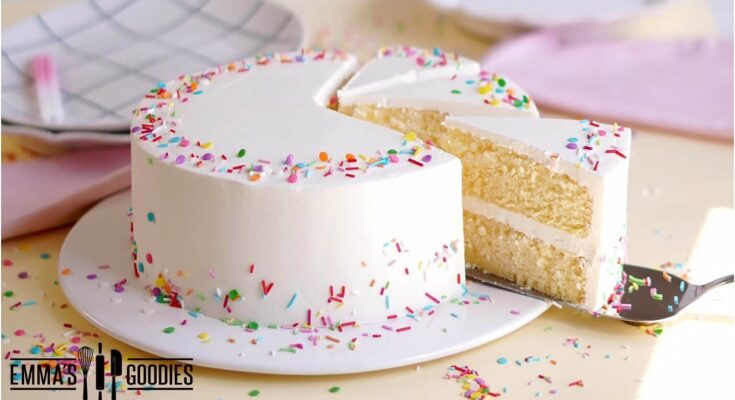Cake Recipe: There’s something magical about baking a cake from scratch. Whether it’s for a birthday, celebration, or simply because you’re craving something sweet, making a cake at home is one of the most satisfying culinary experiences. Not only do you control the ingredients, but you also get to enjoy that warm, fresh-out-of-the-oven aroma that no store-bought cake can match.
Baking might seem intimidating at first, but with the right recipe and step-by-step guidance, anyone can bake a delicious, fluffy cake. Let’s dive in and walk through the entire process, from gathering the ingredients to that first celebratory bite!
Types of Cakes You Can Make
There are endless types of cakes, but here are some classics:
- Classic Sponge Cake: Light and airy with a subtle sweetness.
- Chocolate Cake: Rich and decadent, perfect for chocoholics.
- Vanilla Butter Cake: Simple yet delicious with a buttery flavor.
- Carrot Cake: Moist and flavorful, often topped with cream cheese frosting.
This guide focuses on a classic butter cake recipe, which is easy to modify into different flavors.
Ingredients Required for a Basic Cake
Here’s a simple list of ingredients you’ll need for a standard cake:
Dry Ingredients:
- 2 cups all-purpose flour
- 1 ½ tsp baking powder
- ½ tsp salt
Wet Ingredients:
- 1 cup unsalted butter (softened)
- 1 ¼ cups sugar
- 3 large eggs
- 1 tsp vanilla extract
- ¾ cup whole milk
Optional Flavor Additions:
- Zest of a lemon or orange
- Chocolate chips or cocoa powder
- Spices like cinnamon or nutmeg
Tools You’ll Need
- Mixing Tools: A hand mixer or stand mixer, and a whisk
- Baking Pans: 9-inch round or square pans
- Measuring Cups & Spoons: For accurate measurements
Preparation Before You Start Baking
- Preheat the Oven: Set your oven to 350°F (180°C).
- Line and Grease the Pan: Use parchment paper to line the bottom, and grease the sides with butter or oil.
How to Make Cake Recipe – Step by Step Guide
Step 1: Measuring the Ingredients Accurately
Baking is all about precision. Use measuring cups for dry ingredients and liquid measuring cups for wet ones. Avoid scooping flour directly from the bag—spoon it into the measuring cup and level it off with a knife.
Step 2: Mixing the Dry Ingredients Together
In a large bowl, whisk together the flour, baking powder, and salt. This ensures the leavening agents are evenly distributed throughout the batter, helping your cake rise evenly.
Step 3: Creaming Butter and Sugar
In another bowl, beat the softened butter and sugar together until the mixture becomes light and fluffy. This can take 3-5 minutes with a hand mixer. This step creates air pockets, which result in a lighter cake.
Step 4: Adding Eggs One at a Time
Add the eggs one by one, beating well after each addition. This prevents the batter from curdling and ensures the eggs are fully incorporated.
Step 5: Incorporating Dry Ingredients and Milk
Add the dry ingredients to the wet mixture in three batches, alternating with the milk. Begin and end with the dry ingredients. Mix gently to avoid overworking the batter, which can make the cake dense.
Step 6: Pouring the Batter into the Pan
Pour the batter into your prepared pan and spread it evenly with a spatula. Tap the pan gently on the counter to release any trapped air bubbles.
Step 7: Baking the Cake
Place the pan in the preheated oven and bake for 30-35 minutes. Check for doneness by inserting a toothpick into the center—if it comes out clean, your cake is ready.
Step 8: Letting the Cake Cool Properly
Let the cake cool in the pan for 10 minutes, then transfer it to a wire rack to cool completely. This prevents the cake from becoming soggy and makes it easier to frost later.
Optional Step: Frosting and Decoration Ideas
- Buttercream Frosting: Beat 1 cup of butter with 3 cups of powdered sugar and 2 tbsp milk until smooth.
- Chocolate Ganache: Heat ½ cup heavy cream and pour over 1 cup of chopped chocolate. Stir until smooth.
- Creative Decorations: Add sprinkles, fruit slices, or edible flowers for a fun touch.
Cooling and Decorating Your Cake
Let the Cake Cool Properly
Once baked, allow the cake to cool in the pan for 10-15 minutes before transferring it to a wire rack. Let it cool completely before adding any frosting.
Simple Icing or Frosting Ideas
- Buttercream frosting: A classic, creamy option.
- Chocolate ganache: Rich and glossy for chocolate lovers.
- Whipped cream and fruit: Light and refreshing.
Common Cake-Making Mistakes to Avoid
Not Measuring Ingredients Properly
Always measure ingredients carefully to avoid an imbalanced batter.
Overmixing the Batter
Mixing too much can develop too much gluten, making the cake dense.
Opening the Oven Too Early
This can cause the cake to collapse. Avoid opening the door before 30 minutes have passed.
FAQs about Cake Recipe
1. What are the basic ingredients needed for a cake?
Most cake recipes require some essential ingredients: flour, sugar, eggs, butter or oil, a leavening agent like baking powder or baking soda, and a liquid such as milk or water. Variations might include vanilla extract, cocoa powder, or spices to flavor the cake.
2. How do I ensure my cake is moist and fluffy?
To achieve a moist and fluffy texture, ensure that you measure your ingredients accurately. Overmixing the batter can lead to a dense cake, so mix just until the ingredients are combined. Also, make sure your leavening agents are fresh to guarantee a good rise.
3. Can I make a cake without eggs?
Yes, you can make a cake without eggs by using substitutes such as applesauce, mashed bananas, yogurt, or commercially available egg replacers. Each substitute can affect the flavor and texture, so it might be worth experimenting to find which works best for your recipe.
4. How long should I bake my cake?
Baking times vary depending on the type of cake and the size of the pan. Typically, a standard 9-inch cake will bake for 25-35 minutes at 350°F (177°C). It’s best to check the cake a few minutes before the recommended baking time and test it by inserting a toothpick into the center. If it comes out clean, the cake is done.
5. Why did my cake sink in the middle?
A cake might sink for several reasons: if the oven door is opened too early during baking, if the cake is underbaked, or if there’s too much leavening agent. Ensuring the correct oven temperature and baking time can help avoid this issue.
6. Can I freeze a baked cake?
Yes, most cakes freeze well for up to three months. Allow the cake to cool completely before wrapping it tightly in plastic wrap and then in foil. Thaw the cake overnight in the refrigerator before serving.
Conclusion
And there you have it! A beautifully baked cake made from scratch, step by step. Whether you’re indulging in a slice yourself or sharing it with friends, nothing beats the satisfaction of baking your own cake. Just follow this guide, and you’ll have a cake that’s moist, fluffy, and full of flavor every time. Enjoy the process – baking is an art that rewards patience and precision!
References
For further reading and validation of the information provided in our Cake Recipe with Post Links, consider exploring these reputable sources:
- Epicurious: Discover a variety of baking techniques and tips for perfecting your cakes at Epicurious.com.
- Allrecipes: For additional cake recipes and user reviews, visit Allrecipes.com. This platform provides insights from a community of home cooks on how different variations of the recipes worked for them.
- King Arthur Baking: Enhance your baking skills by accessing detailed guides and the science behind baking at King Arthur Baking. They offer comprehensive explanations on why certain ingredients and methods are used in baking.
- Food Network: Find expert advice and professional baking techniques at Food Network. Their collection includes recipes from renowned chefs and baking shows.
- Serious Eats: Dive into the food science and detailed culinary techniques that can help you bake the perfect cake at Serious Eats.
These sources are well-respected in the culinary world and provide reliable information that can help you refine your baking skills and explore new ideas.



